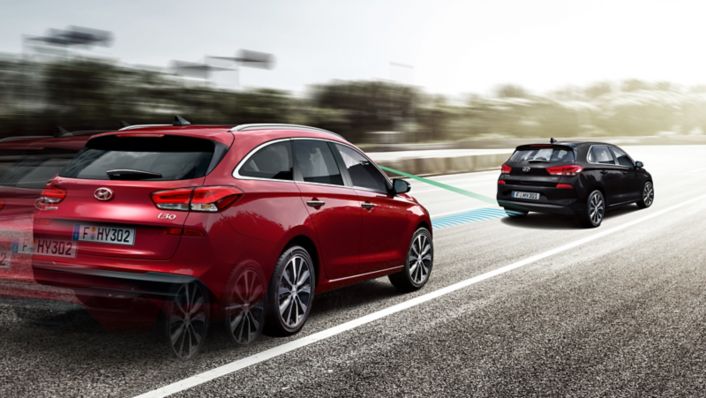As automated features become more standard in today’s cars, cruise control may not seem like the latest advancement. However, its introduction marked a pivotal moment in the evolution toward autonomous driving. Cruise control is engineered to enhance occupant safety and comfort while also increasing fuel efficiency and cost-effectiveness. It proves especially beneficial on extended journeys on the motorway or less congested roads as it minimises driver fatigue and helps to maintain a consistent speed within legal limits.
What is cruise control?
Cruise control is a system in a car that allows the driver to set a constant speed. To activate cruise control, the driver typically uses a button or lever – often located on the steering wheel. Once set, the system takes over throttle control, maintaining the selected speed. This feature helps to reduce driver fatigue by allowing the driver to relax their foot from the accelerator pedal. An indicator light usually shows that cruise control has been activated. Deactivating the system is straightforward – either by pressing the brake pedal or by repressing the activation button. Doing so returns full control over speed to the driver.

When was cruise control invented?
While speed control dates to the early 20th century, modern cruise control was pioneered by American engineer and investor Ralph Teetor in 1948. His journey toward creating cruise control began during World War II when national speed limits were imposed to conserve fuel. The idea came to him while riding in a car driven by his lawyer, who had a habit of fluctuating speed while talking.
Drawing from his expertise in automatic transmission, Teetor devised a solution to this erratic driving behaviour. His invention utilised the rotations of the vehicle’s driveshaft to calculate ground speed and employed a bidirectional screw-drive electric motor to adjust throttle position accordingly. His invention not only enhanced driving comfort but also improved fuel efficiency and safety.
In 1950, Teetor obtained a patent for a “speed control device for resisting operation of the accelerator”, laying the groundwork for the cruise control systems we use today. By the 1970s, cruise control had become a staple in vehicles across various manufacturers.
Modern cruise control
By the early 1990s, advancements in automotive technology, specifically in LiDAR, radar, sonar, and cameras, significantly enhanced vehicle safety and navigational capabilities. These technologies form the backbone of modern vehicles, especially with the advent of autonomous driving systems.
The synergy between LiDAR, radar, and camera technologies ensures comprehensive environmental monitoring, crucial for the safety and effective operation of future autonomous systems. LiDAR technology uses laser light to create high-resolution 3D maps of the environment – essential for functions like obstacle detection, road sign recognition, and collision avoidance. This is complemented by modern radar systems with extended range and enhanced resolution. Cameras in cars provide essential visual data that support numerous functions, such as lane keeping, traffic sign recognition, and driver monitoring.

Hyundai’s Smart Cruise Control and beyond
Hyundai’s Smart Cruise Control (SCC) suite represents a leap forward in automotive technology. At its core, SCC aims to reduce driver stress while enhancing safety by intelligently managing speed and distance from other vehicles on the road.
To provide the safest and most convenient driving experience, Hyundai is continuously listening to its customers and updating its safety features accordingly. For example, the company has enhanced ISLA. Drivers now have great control over the feature, being able to adjust the sound level of the alert with just a press of a button without compromising on safety.
With the introduction of SCC with Stop & Go, Hyundai took the system a step further, addressing the challenges of congested traffic. Not only does SCC adjust speed according to traffic flow, but it can also bring the vehicle to a complete stop if necessary. When traffic halts, the system applies the brakes until the car stands still, then smoothly accelerates back to the preset speed once the road clears. If the vehicle stops for longer than three seconds, the driver must activate the system again with the steering wheel controls or by briefly pressing the accelerator pedal.
But safety isn’t just about reacting to the environment; it’s also about anticipating potential risks. That is where SCC2 with Emergency Stop comes into play. By recognising driver inattention or lack of response via the In-Cabin Camera (ICC) or Hands-On Detection (HOD), SCC2 takes control, centring the vehicle in its lane and bringing it to a halt if needed, both warning the driver and alerting those outside the vehicle. The function will be available soon.

The groundbreaking SCC-Machine Learning (SCC-ML) learns and adapts to the driver’s driving style – among others, inter-vehicle distance, acceleration, and reaction time, dynamically adjusting its behaviour to match their preferences. By leveraging machine learning algorithms, SCC-ML ensures a more personalised driving experience.
Navigation-based SCC-Curve (NSCC-C) takes anticipation to a new level. By analysing navigation data, NSCC-C predicts upcoming curves in the road, proactively adjusting cruising speed to ensure a smooth and safe transition. This not only enhances comfort but also improves efficiency by optimising speed through corners.
As technology advances, the future of cruise control is poised to evolve through seamless integration with increasingly sophisticated driver assistance systems, paving the way for a smoother transition toward fully autonomous vehicles. This shift promises not only enhanced safety and efficiency but also a significant reduction in the dependence on human drivers, revolutionising the landscape of mobility.















